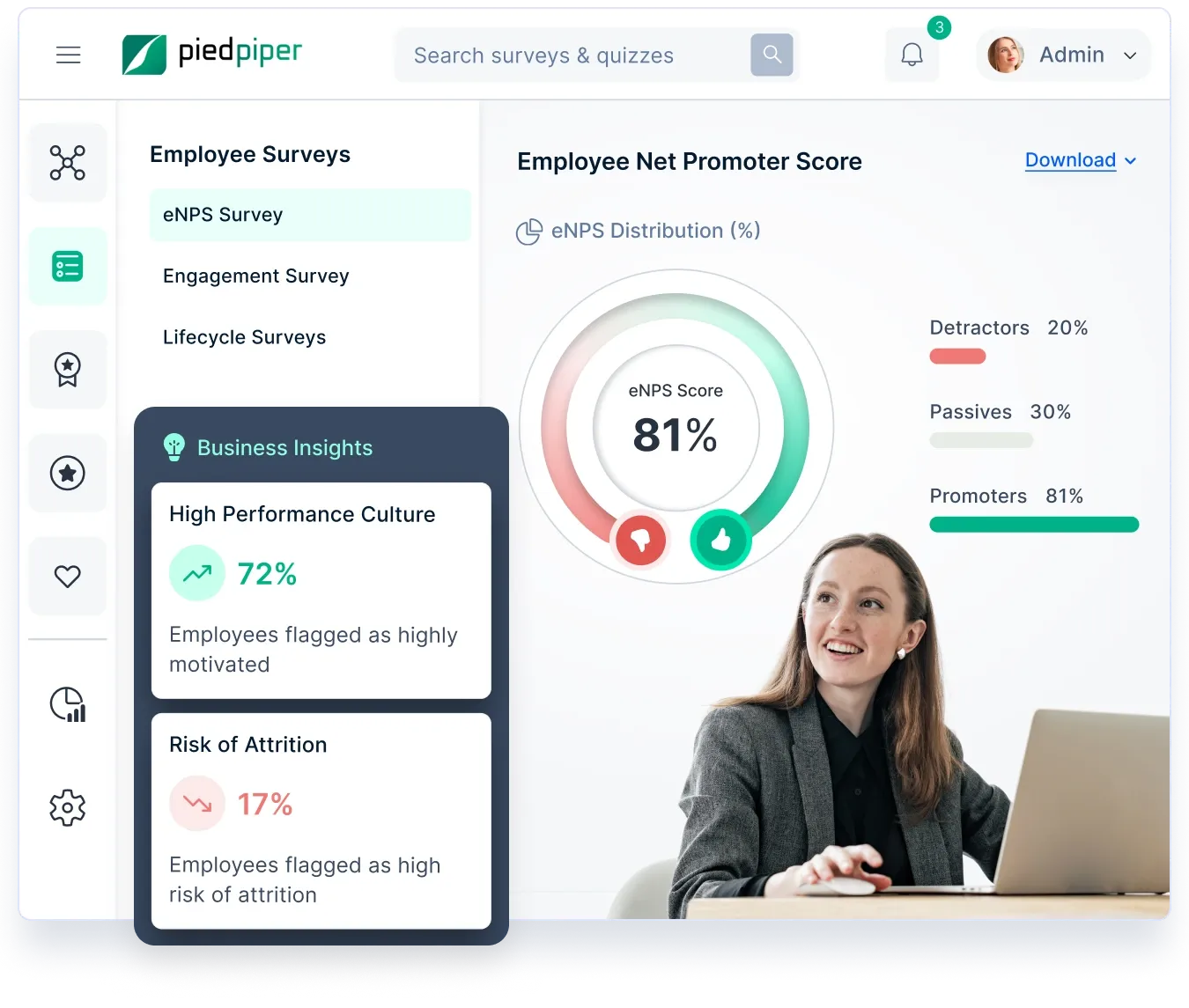Demotivasi di Tempat Kerja: Tanda, Penyebab, dan Cara Memotivasi Karyawan yang Kehilangan Motivasi
Employee demotivation can impact productivity, morale, and retention. Learn to identify signs of demotivated employees, understand the causes of demotivation in the workplace, and apply effective strategies to motivate a demotivated employee before disengagement spreads.
Di halaman ini
Even the most engaged and high-performing teams experience slumps. One moment, your employees are proactive and energized; the next, they’re disengaged, making errors, and struggling to complete routine tasks. This shift isn’t always due to laziness or lack of ability—it's often a sign of employee demotivation creeping in.
Ignoring these warning signs can have serious consequences. A lack of motivation spreads quickly, impacting productivity, morale, and even retention rates. Recognizing the signs of demotivated employees early on is crucial for managers who want to maintain a thriving work environment. From missed deadlines to increased absenteeism, the indicators are often clear—but the root cause isn’t always obvious.
Understanding the causes of demotivation in the workplace is the first step toward reversing it. Whether it’s due to a lack of recognition, unclear expectations, or excessive workload, pinpointing the factors leading to demotivation allows leaders to take meaningful action.
But knowing how to motivate a demotivated employee is what truly makes a difference. With the right strategies, you can re-energize your workforce, rebuild engagement, and create an environment where employees feel valued and driven to perform their best.
10 Tanda-tanda karyawan yang terdemotivasi di tempat kerja
Sekarang mari kita bahas gejala atau tanda-tanda demotivasi yang menonjol di tempat kerja, yang memang menjadi ciri-ciri karyawan yang mengalami demotivasi di era new normal:
1. Ketidakhadiran atau keterlambatan yang konsisten
Apakah peserta magang manajemen yang biasanya bekerja lembur selama tenggat waktu proyek berubah menjadi eksekutif yang 'selalu terjebak macet'? Apakah eksekutif yang dulunya 'tidak pernah absen' kini memiliki alasan baru yang brilian untuk bolos kerja?
Sebuah studi pada tahun 2012 menemukan bahwa korelasi positif tertinggi dari 'konservasi waktu' adalah 'pikiran untuk bekerja'. Ini merupakan salah satu dari 21 faktor organisasi yang disajikan kepada 402 karyawan dari lima perusahaan di NCR, Delhi.
The study thus indicates that those punctual people out there - are business drivers, too. Time to carve a plan of employee engagement and motivation if your employees have daily hassles with traffic.
2. Sikap apatis
Apakah salah satu anggota tim Anda bertingkah laku seperti pasangan Anda saat suasana hatinya sedang buruk? Seolah-olah mereka hanya ingin ditinggal sendirian? Hal ini terjadi bahkan selama musim kenaikan ketika anggota tim lainnya keluar dengan diri mereka yang spektakuler? Lebih baik periksa orang ini.
S. Bishvas’s 2010 study surveyed 357 managers/executives from manufacturing and service sector companies, studied their responses on five factors - psychological climate, job satisfaction, job involvement, turnover intention, and organizational effectiveness – and concluded that there was a high positive influence of psychological stress climate over job satisfaction.
Dengan kata lain, jika ada indikasi tekanan psikologis pada seorang karyawan - ini juga merupakan tanda bahaya bagi pemimpin.
3. Konflik dengan rekan kerja/atasan
An employee retention study by Iowa State University showed that stayers engaged in more positive behaviors than leavers. Have suddenly the rights become too vast or flexibility too undefined?
Apakah Anda merasa digambarkan seperti seorang kapitalis setiap kali Anda memenuhi tanggung jawab pekerjaan Anda dalam manajemen kinerja tim? Saatnya untuk konferensi rekonsiliasi.
4. Terus-menerus stres/bosan
Penelitian H J Carla terhadap 700 karyawan di berbagai agensi menengah dan besar di South Carolina menunjukkan bahwa keterlibatan karyawan adalah kunci untuk mempertahankan para pekerja saat ini.
Jika Anda tahu bahwa tidak ada cukup pekerjaan bagi salah satu anggota tim Anda untuk berada di meja kerja setiap saat dan jika orang tersebut tidak mau mengambil waktu istirahat secara teratur, maka sangat penting untuk mencari tahu alasannya.
No, they are not having a heated break-up discussion over messages - which you are sympathetic about – they are scoring high in a recently downloaded arcade game over your office Wi-Fi. Better check out their scores!
5. Memimpin diskusi negatif
S. Biswas menguraikan pengamatannya dalam sebuah studi tahun 2010. Dia mengatakan:
"Jumlah keterlibatan seseorang dalam pekerjaannya akan bergantung pada kekuatan afirmatif yang secara psikologis dia rasakan terhadap berbagai aspek pekerjaan dan lingkungan pekerjaannya."
Jadi, ketika anggota tim Anda terdeteksi semakin sinis terhadap inisiatif keberlanjutan dan manajemen perusahaan - tidak diragukan lagi, inilah saatnya untuk menggali lebih dalam.
6. Penurunan produktivitas dan kualitas kerja yang buruk
Studi Bakotić terhadap 40 perusahaan Kroasia berskala besar dan menengah menghasilkan korelasi yang signifikan antara kepuasan kerja dan indikator keuangan produktivitas organisasi.
Laporan yang tidak lengkap, lembar data yang salah, dan terlalu banyak waktu menganggur adalah indikator umum untuk rapat tinjauan sementara. Bisa juga karena kemungkinan adanya semangat yang patah - lebih baik cari tahu.
7. Mengundurkan diri dari acara-acara keterlibatan karyawan
Studi Erdila et al pada 195 karyawan yang bekerja di bawah supervisor di Istanbul secara empiris menunjukkan bahwa kesenangan di tempat kerja berhubungan positif dengan keterlibatan dan tanggung jawab.
Apakah kupu-kupu sosial sekarang menjadi ngengat dalam ruangan? Anda perlu melihat kembali inklusivitas program karyawan Anda atau mengobrol dengan si kupu-kupu.
8. Tidak melakukan inisiatif baru
Harte et al, dalam penelitian mereka yang dilakukan di 36 perusahaan dan dengan responden sebanyak 198514 orang, menyimpulkan bahwa keterlibatan karyawan berhubungan dengan hasil bisnis yang berarti dengan besaran yang signifikan di seluruh perusahaan.
Lihatlah file lama yang berdebu berjudul 'Metode untuk memaksimalkan efisiensi proses asinkron yang selaras dengan siklus proses bisnis,' dan tinggalkan napas panjang tentang betapa intensifnya proyek-proyek magang tanpa bayaran. Tidak ada inisiatif dari 'pemagang yang dulu dan sekarang menjadi rekan kerja? Waktunya habis untuk pertemuan empat mata yang intens.
9. Meningkatnya aktivitas di situs jejaring profesional
A statistic published by Linkedin tells that out of the 200 million who log in to Linkedin daily, 22 million apply for a job.
Sering melihat pemberitahuan tentang pembaruan di halaman profesional anggota tim Anda? Tampaknya juga bukan pembaruan status yang tidak berbahaya, tetapi peluncuran ulang seluruh profil? Kemungkinan besar 22 Juta sekarang memiliki nilai tambah.
10. Tidak berkontribusi secara bertanggung jawab dalam diskusi
Has the ‘can’t-stop-asking-questions’ person turned to a ‘can’t-keep-eyes-open’ person? Herzberg's motivation-hygiene theory famously quotes ‘responsibility, opportunity to do something meaningful’ as prime motivation factors.
Tidak adanya inisiatif untuk terlibat dalam kesempatan yang disediakan oleh organisasi menunjukkan bahwa orang tersebut tidak lagi menganggapnya sebagai faktor motivasi.
Causes of employee demotivation in the workplace
Employee morale, unquestionably, is one of the most vital but most difficult things to manage in a company.
Semangat kerja yang rendah secara konsisten dapat menjadi masalah serius bagi organisasi Anda, karena karyawan yang tidak bahagia akan mengakibatkan perputaran karyawan yang lebih tinggi, layanan pelanggan yang buruk, dan produktivitas yang lebih rendah.
Therefore, understanding what are the possible factors that are causing low staff morale or low employee motivation can help to fight the challenge head-on.
Here are some of the most common factors that demotivate employees:
1. 1. Kurangnya pengembangan profesional/pribadi

Karyawan terus mencari peluang untuk berkembang dalam peran mereka saat ini dan ditantang dengan cara-cara baru, dengan proyek/tugas baru, dll.
Ketika karyawan gagal melihat bagaimana jenjang karier mereka akan berkembang dalam organisasi, atau bagaimana mereka dapat mengembangkan keterampilan profesional mereka saat melakukan apa yang mereka lakukan, hal itu bisa sangat tidak memuaskan.
When workers believe they lack the capacity to carry out a task, they won’t be motivated to do it.
2. Kurangnya kejelasan

Tidak ada yang dapat menurunkan semangat kerja karyawan selain ketidakjelasan. Ketika karyawan tidak tahu apa yang diharapkan dari mereka atau apa tujuan organisasi, mereka akhirnya menghabiskan waktu berhari-hari (terkadang berminggu-minggu) untuk mengerjakan tugas yang sama -tanpa hasil yang konkret.
Hal ini tidak hanya menghalangi karyawan untuk bekerja dengan kemampuan terbaiknya, namun juga mendemotivasi dan membuat mereka tidak bersemangat. Ketika sebuah tugas tidak berhubungan atau berkontribusi pada sesuatu yang dihargai oleh karyawan, mereka tidak akan termotivasi untuk melakukannya.
3. Ketidakamanan Pekerjaan
Employees who work for unstable companies or in jobs that are insecure will only invest enough to keep getting their paycheck while they look elsewhere. The rest of their energy will be spent sharing rumors with co-workers, updating their resumes, and planning their next move.
Hal terbaik yang bisa Anda lakukan adalah sering berkomunikasi dan memberikan rasa loyalitas dan kepercayaan kepada tim Anda. Anda harus mencari tahu mengapa karyawan merasa tidak aman dalam bekerja dan mengurangi alasan-alasan tersebut. Tingkat gesekan yang tinggi dapat menyebabkan masalah moral di seluruh organisasi.
4. Kurangnya komunikasi

Kurangnya komunikasi adalah salah satu faktor demotivasi karyawan yang paling menantang. Perubahan bisa jadi sangat besar dan sulit untuk dihadapi.
Baik itu perubahan dalam kepemimpinan, lingkungan kerja, struktur tim, dll., atau peralihan mendadak untuk bekerja dari rumah (dalam situasi seperti pandemi COVID-19 baru-baru ini), perubahan bisa sangat menantang.
Ketika hal ini disertai dengan kurangnya komunikasi, hal ini hanya akan menimbulkan kebingungan, ambiguitas, dan penurunan keterlibatan.
5. Kurangnya fleksibilitas di tempat kerja
Meskipun sebagian besar karyawan Anda memahami bahwa beban kerja dapat naik dan turun, namun mengharuskan anggota staf Anda untuk mengikuti beban kerja yang tidak masuk akal dalam jangka waktu yang lama dapat mengakibatkan kelelahan dan kebencian.
Also, if your company policies are so stringent that it's making the work more complex and tough for your employees rather than helping them succeed at work, then such policies do more harm than good.
Jika stres dan kelelahan kerja menyebabkan masalah kesehatan pada karyawan, hal ini tentu saja akan menyebabkan demotivasi karyawan.
6. Merasa tidak terlihat di tempat kerja

Orang-orang ingin dihargai atas upaya dan dedikasi mereka. Ketika manajer gagal mengenali kerja keras dan dedikasi karyawan mereka, hal ini sering kali membuat karyawan merasa tidak terlihat dalam organisasi - yang selanjutnya menyebabkan hilangnya harga diri, rendahnya semangat kerja, dan ketidakpuasan.
7. Failing to address company mission, vision & values
Jika ada masalah yang konsisten di sekitar beberapa kebijakan yang terkait dengan departemen atau gender atau lokasi dan masalah tersebut tidak diatasi, maka ada kemungkinan besar bahwa karyawan akan mulai kehilangan motivasi untuk bekerja di perusahaan.
Mereka merasa tidak aman dan mulai memiliki kepercayaan yang lebih rendah terhadap manajemen. Isu-isu ini dapat terkait dengan kesalahan informasi publik, pemecatan, bias gender, pelecehan seksual, bias ras, dan sebagainya.
Jika perusahaan tidak menyelidiki atau bertindak atas suatu masalah pelanggaran berat, maka moral karyawan dapat rusak.
8. Kurangnya kepercayaan atau manajemen mikro

Managers often tend to get into micromanagement of their team members’ work when they don’t trust them enough.
Mereka cenderung terlibat dalam setiap langkah pelaksanaan proyek, memberi tahu karyawan mereka apa yang harus dilakukan, bagaimana melakukannya, dan terkadang duduk bersama mereka untuk menyelesaikannya dengan cara mereka.
Hal ini membuat frustasi, menurunkan semangat, dan menurunkan motivasi. Orang-orang mengharapkan tingkat kebebasan dan otoritas tertentu untuk membuat keputusan sendiri dalam batasan peran pekerjaan mereka.
How to motivate a demotivated employee: 6 Most effective ways
Here are six effective ways to motivate a demotivated employee while addressing employee demotivation and the demotivating factors that might be causing it.
1. Identify and address demotivating factors
The first step in understanding how to motivate a demotivated employee is identifying what’s causing their disengagement. Employee demotivation can stem from several demotivating factors, such as unclear job expectations, lack of recognition, stagnant career growth, or a toxic work environment.
Conducting one-on-one meetings, gathering feedback through anonymous surveys, or having open discussions can help uncover these underlying issues. Once identified, take corrective actions like clarifying job roles, improving team dynamics, or addressing workload concerns. Employees feel valued when they know their concerns are heard and actively addressed.
2. Provide meaningful recognition and appreciation
A major demotivating factor is feeling unappreciated. Employees who don’t receive recognition for their hard work often lose interest and engagement. A simple ‘thank you’ or acknowledging their contributions in team meetings can uplift their spirits. However, recognition should be structured and meaningful rather than just an occasional appreciation.
Platforms like Empuls offer a seamless way to implement an effective rewards and recognition system. Organizations can appreciate employees through peer-to-peer recognition, milestone rewards, and performance-based incentives. Integrating such tools can create a culture where employees feel valued, boosting motivation and workplace morale.
3. Offer opportunities for growth and development
Employees who see no career progression or skill development in their role are likely to experience employee demotivation. The absence of learning opportunities and stagnant roles can make them disengaged.
Providing skill-building workshops, mentorship programs, and clear career growth paths can reignite their enthusiasm. Assigning them to meaningful projects that challenge their skills or sponsoring professional development courses can also make a difference. Employees who see a future in the organization stay more committed and driven.
4. Improve work-life balance and reduce stress
Burnout and excessive workload are among the most common demotivating factors. When employees feel overworked without sufficient breaks or flexibility, their productivity and motivation suffer.
Encourage a healthy work-life balance by offering remote work options, flexible schedules, or wellness initiatives. Simple changes like allowing mental health days, reducing unnecessary meetings, and promoting a supportive work environment can lead to significant improvements in motivation. Employees who feel their well-being is prioritized are more engaged and committed to their work.
5. Set clear goals and provide autonomy
Unclear expectations and micromanagement often contribute to employee demotivation. Employees need to understand their role, what’s expected of them, and how their contributions impact the bigger picture. Without clear direction, they may feel lost or undervalued.
Set measurable and achievable goals while allowing employees to execute tasks their way. Avoid constant supervision—trusting employees with responsibilities fosters confidence and motivation. When they have ownership over their work, they feel more accountable and invested in their tasks.
6. Conduct employee surveys and act on feedback
Understanding how to motivate a demotivated employee requires continuous feedback. Conducting employee surveys helps in identifying demotivating factors that might be causing disengagement. However, collecting feedback is just the first step—acting on it is what truly makes a difference.
Empuls offers an advanced employee survey tool that helps organizations track engagement levels, collect honest feedback, and implement necessary changes.
Regular pulse surveys, engagement check-ins, and satisfaction assessments allow HR teams to address workplace concerns before they escalate. When employees see that their input leads to real improvements, they feel more valued and motivated.
Organizations can create an engaging and rewarding work environment by addressing demotivating factors and implementing structured ways to motivate a demotivated employee. Investing in recognition, career development, work-life balance, autonomy, and employee feedback leads to long-term motivation and retention.
Reignite employee motivation with Empuls
Demotivation doesn’t happen overnight. It creeps in when employees feel unheard, unappreciated, or disconnected from their work. A lack of recognition, unclear communication, and an uninspiring workplace culture can quickly lead to disengagement and lower productivity. Empuls helps businesses turn this around by creating an environment where employees feel valued, motivated, and excited to contribute.
Uncover the root causes of demotivation

Employee disengagement isn’t always obvious. Some might struggle with unclear goals, while others feel their contributions go unnoticed. Empuls’ Employee Survey Tool gives employees a voice by collecting real-time feedback. By analyzing engagement trends and pinpointing concerns, organizations can take proactive steps to address workplace frustrations and create a culture where employees feel heard and supported.
Recognize and reward achievements to boost morale

Employees thrive when their hard work is acknowledged. Empuls' Rewards & Recognition platform makes appreciation a seamless part of workplace culture by enabling peer-to-peer recognition, instant rewards, and leadership-driven appreciation. Whether it’s a simple shoutout, a tangible reward, or a structured incentive program, recognition fuels motivation and helps employees stay engaged.
Make milestones meaningful
Celebrating professional milestones isn’t just about acknowledging tenure—it’s about reinforcing commitment and loyalty. Empuls’ Milestone Rewards ensures that every work anniversary, project completion, or performance achievement feels special with personalized rewards and heartfelt appreciation. Employees who feel valued for their long-term contributions remain motivated to stay and grow with the organization.
Create a thriving company culture

A workplace culture that fosters inclusivity, collaboration, and recognition is a powerful antidote to demotivation. Empuls’ Company Culture Software helps build a strong foundation by creating a space where employees can connect, share ideas, and engage in meaningful discussions. A positive culture transforms workplaces from transactional environments into spaces where employees feel inspired and invested in their roles.
Strengthen communication and workplace connections

Poor communication can quickly lead to disengagement, leaving employees feeling isolated and uninformed. Empuls’ Social Intranet acts as a dynamic communication hub where teams can stay updated, participate in discussions, and build a sense of community.
From leadership announcements to team-wide conversations, it ensures that employees feel connected, valued, and part of something bigger.
Demotivation thrives in environments where employees feel overlooked, but Empuls turns disengagement into enthusiasm, fostering a workplace where every individual feels recognized, empowered, and connected.
Kesimpulan
Employee demotivation isn’t just an individual problem—it affects team dynamics, productivity, and overall workplace culture. Ignoring the signs of demotivated employees can lead to disengagement spreading across the organization, making it harder to recover.
By identifying the causes of demotivation in the workplace, whether it's lack of recognition, unclear goals, or poor work-life balance, leaders can take proactive steps to address the issue. Creating a supportive environment, offering growth opportunities, and using tools like Empuls for recognition and feedback can make a significant difference.
Motivating employees isn’t about quick fixes—it’s about fostering a workplace where people feel valued, heard, and empowered. When businesses invest in their employees' well-being and motivation, they build a culture of engagement, loyalty, and long-term success.













